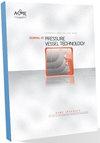一种用于量化螺栓法兰垫圈接头腐蚀的改进夹具
IF 1.4
4区 工程技术
Q4 ENGINEERING, MECHANICAL
Journal of Pressure Vessel Technology-Transactions of the Asme
Pub Date : 2023-11-02
DOI:10.1115/1.4063975
引用次数: 0
摘要
摘要本研究讨论了螺栓-法兰-衬垫连接系统的腐蚀行为。提出了一种新的夹具来量化在使用条件下垫片-法兰界面的腐蚀。由于衬垫和法兰之间存在裂缝和潜在的差异,腐蚀广泛发生在这些连接处。缝隙腐蚀和电偶腐蚀会造成加压流体泄漏,并可能导致灾难性的破坏。先前对螺栓密封接头的腐蚀进行了研究;然而,没有报告操作条件的影响。操作条件包括流体流量、压力、pH值、电导率、温度和垫片接触压力。本研究首先介绍了一种新的实验装置来检查螺栓法兰垫圈连接的腐蚀行为。开发的夹具由加压螺栓垫圈连接组成,可以实时监控和记录使用条件影响下的腐蚀参数。其次,通过动电位极化试验测量了一对法兰和垫片材料的腐蚀速率,获得了腐蚀行为数据。这些测试是使用新的设置,再现工业螺栓法兰垫圈连接系统的行为。它由工作电极(法兰材料)、参比电极(Ag/AgCl)和辅助电极(不锈钢棒)组成。用0.6 M NaCl溶液对三种类型的石墨垫片进行电化学腐蚀试验。通过共聚焦激光显微镜检查试样腐蚀表面的形貌。本文章由计算机程序翻译,如有差异,请以英文原文为准。
An Improved Fixture to Quantify Corrosion in Bolted Flanged Gasketed Joints
Abstract This study discusses the corrosion behavior of bolted flanged gasketed joint systems. A novel fixture is proposed to quantify the corrosion at the gasket-flange interface under services conditions. Due to the presence of crevices and potential differences between gaskets and flanges, corrosion widely occurs in such joints. Crevice corrosion and galvanic corrosion can create paths to leakage of the pressurized fluid and may cause catastrophic failure. Corrosion in bolted gasketed joints was investigated previously; however, the effects of the operating conditions were not reported. Operating conditions include fluid flow, pressure, pH, conductivity, temperature, and gasket contact pressure. This study starts by introducing a new experimental setup to examine the corrosion behavior of bolted flanged gasketed joints. The developed fixture consists of a pressurized bolted gasketed joint that enables real-time monitoring and recording of the corrosion parameters under the influence of service conditions. Secondly, potentiodynamic polarization testing is conducted to measure the corrosion rate and obtain data on the corrosion behavior of a pair of flange and gasket materials. These tests are performed using the novel setup that reproduces the behavior of industrial bolted flanged gasketed joint systems. It consists of a working electrode (flange material), a reference electrode (Ag/AgCl), and an auxiliary electrode (a stainless-steel rod). Three types of graphite gaskets compressed in the fixture are subject to electrochemical corrosion tests with a 0.6 M NaCl solution. The morphology of the specimen's corroded surfaces is examined via confocal laser microscopy.
求助全文
通过发布文献求助,成功后即可免费获取论文全文。
去求助
来源期刊
CiteScore
2.10
自引率
10.00%
发文量
77
审稿时长
4.2 months
期刊介绍:
The Journal of Pressure Vessel Technology is the premier publication for the highest-quality research and interpretive reports on the design, analysis, materials, fabrication, construction, inspection, operation, and failure prevention of pressure vessels, piping, pipelines, power and heating boilers, heat exchangers, reaction vessels, pumps, valves, and other pressure and temperature-bearing components, as well as the nondestructive evaluation of critical components in mechanical engineering applications. Not only does the Journal cover all topics dealing with the design and analysis of pressure vessels, piping, and components, but it also contains discussions of their related codes and standards.
Applicable pressure technology areas of interest include: Dynamic and seismic analysis; Equipment qualification; Fabrication; Welding processes and integrity; Operation of vessels and piping; Fatigue and fracture prediction; Finite and boundary element methods; Fluid-structure interaction; High pressure engineering; Elevated temperature analysis and design; Inelastic analysis; Life extension; Lifeline earthquake engineering; PVP materials and their property databases; NDE; safety and reliability; Verification and qualification of software.

 求助内容:
求助内容: 应助结果提醒方式:
应助结果提醒方式:


